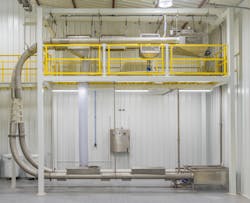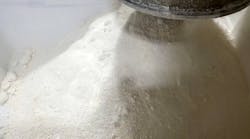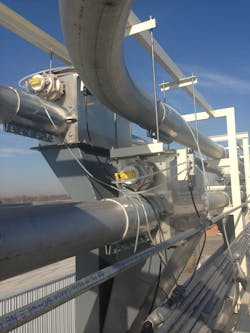New tubular drag cable conveyors provide improved metrics for powder and bulk solids processors
When processing and handling dry bulk solids, industry professionals such as engineers, operations managers and quality control personnel must maintain all required product specifications for the materials conveyed.
Nevertheless, the market drives processors to convey powder and bulk materials more efficiently without compromising safety. Processors have desired a safer, more energy-efficient means to convey materials with less particle breakage, contamination risk, spillage and downtime for cleaning and maintenance. While tubular drag cable conveyors have long provided these attributes, for high-volume applications, processors have often selected more traditional conveying options such as belt, bucket and pneumatic systems.
Fortunately, 8-inch-diameter tubular drag cable conveyors that basically double the volume of a 6-inch unit have become widely available. This provides comparable throughput and pricing to conventional conveying systems.
Tubular drag cable conveyors gently move material through a sealed tube using a coated, flexible stainless-steel drag cable on a loop with solid circular discs (called flights) attached to the cable at regular intervals. As the cable is dragged through the tube, the flights push material through the tube without the use of air. These conveyors excel in transporting delicate, precise blends for a wide variety of foods, powders and other bulk solids in versatile layouts and configurations.
To examine the benefits of implementing this larger, higher volume conveying option, I spoke with Bob Owen, director of product performance at Cablevey Conveyors.
Q: What are the main reasons industry professionals are turning to the larger tubular drag cable conveyors? What volumes can the 8-inch tubular drag cable conveyors move?
A: The primary reasons industry professionals are turning to the higher volume tubular drag cable conveyors include improved power use, product quality, safety, product preservation, and production uptime.
Today’s 8-inch tubular drag cable conveyors can move up to 2,000 cubic feet and 80,000 pounds per hour depending on the material’s bulk density. The units are increasingly used to convey various powders and bulk solids.
Q: How can 8-inch tubular drag cable conveyors reduce energy costs?
A: As energy prices continue to rise, processors are paying more attention to reducing the power required to convey materials. Within plants, the motors needed to convey large volumes of food materials can vary greatly in power consumption. At the high end are pneumatic conveyors that use air to move material at high velocity through an enclosed line by creating air pressure above or below the atmospheric level. High-volume pneumatic conveyors generally require larger, power-hungry motors from 20 to 50 HP or more that run fans, blowers and rotary valves.
At the mid-range of power consumption are belt conveyors and bucket elevators. In a typical belt conveyor system, a belt forms a closed loop and stretches across two or more pulleys, with one being a drive pulley that enables the belt to rotate continually. Bucket elevators move material using buckets attached to a rotating belt or chain. The buckets pick up material, carry it to an endpoint, discharge the material, and then return to the starting point to pick up a new load. To convey a similar volume of material as an 8-inch tubular drag cable conveyor, a belt conveyor or bucket elevator would typically require approximately a 25-HP motor.
At the low end of power consumption are 8-inch tubular drag cable conveyors, which usually use a 7.5-HP motor to move a comparable volume of material.
The drag cable pulls the attached flights at low speed through a loop, which requires less energy than conventional methods. The ample size and number of flights on 8-inch units enable the conveyor to move a similar amount of material as traditional belt, bucket, or pneumatic units.
Q: How can 8-inch tubular drag cable conveyors improve product quality?
A: For powder or bulk solid products that are delicate or that present a higher value in undamaged form, preserving product integrity is important. However, the rough mechanical action of scooping and dumping material in a bucket elevator can cause incidental damage, lowering value. The same is true for the high-velocity conveyance of pneumatic systems through vertical and horizontal tubing, turns and sweeps, which can batter particles during the process.
Tubular drag cable conveyors offer a gentler alternative. As the coated, flexible stainless-steel drag cable is pulled through the sealed tube on a loop, the solid circular discs attached to the cable push the material at low speed through the tube without the use of air, preserving product integrity and minimizing waste.
Q: Can you give an example or two of how product value can be preserved by reducing damage using this option?
A: A cereal manufacturer that turned to a high-volume tubular drag cable conveyor was able to reduce product damage. The premium for processing high-value products whole and unblemished can be even greater for some products such as nuts. One food processor that used almonds in its recipe was only able to sell its product for 40 cents per pound if the almonds were damaged but could get $4 per pound if the almonds were whole and undamaged. The processor chose to use a tubular drag cable conveyor to minimize product damage and optimize the sales price.
Q: In terms of safety, what drawbacks can conventional open conveying systems present?
A: Open conveying systems such as bucket elevators and belt conveyors are common in the food industry but have substantial drawbacks in terms of the potential for contamination. With either type of system, any uncovered product can potentially be exposed to contaminants and moisture in the surrounding environment. Open systems also allow product spillage onto the plant floor, which can present a slip and fall hazard if not promptly addressed.
Unlike open systems, tubular drag cable conveyors and pneumatic conveying systems effectively seal off the product from the outside environment and any potential contamination from that source. The enclosed nature of the systems ensures that no dust escapes, which could lead to an unsanitary and potentially dangerous coating of dust on the floor or process equipment. The result is a safer, cleaner, dust-free work environment and reduced risk of dust explosions.
Enclosed systems also eliminate the inherent risk of slip and fall incidents due to product discharge onto the processing area floor.
Q: In terms of product preservation, what advantages can tubular drag cable conveyors offer?
A: Enclosed conveyors prevent the product loss that is intrinsic to open systems such as belt conveyors or bucket elevators. Once a powder or bulk solid product is in the enclosed tube, it cannot fall out, and no powdered product is lost in the form of escaped dust.
Preventing product loss can offer considerable benefits to a processor’s profitability, with surprisingly quick return on investment (ROI) in some cases. For example, an international pet food manufacturer was processing dog kibble, and a bucket elevator was allowing excessive product loss due to spillage. The pet food manufacturer switched to an 8-inch tubular drag cable conveyor to minimize product spillage and reported a 1-year ROI for the system.
Q: How can processors improve production uptime using 8-inch tubular drag cable conveyors?
A: To reduce production downtime, powder and bulk solids processors also increasingly expect conveying systems to be designed for easy cleaning and maintenance. In this regard, bucket elevators are particularly difficult to clean in preparation for production line changeovers. To clean them, each bucket must be time consumingly removed and cleaned inside and out to remove accumulated residue. Belt conveyors are usually cleaned with scrapers, but this can still leave product residue that must be removed with a more thorough method. If the conveyor is not cleaned properly, it can contaminate subsequent food products, which will then need to be discarded, equating to lost profits. Or worse, consumers could be harmed, resulting in costly recalls, damage to the brand and company reputation or even potential litigation and liability.
With closed conveyors, cleaning is also a mixed bag. Pneumatic conveyors can still be relatively time consuming to clean and sanitize if any manual procedures are involved. Tubular drag cable conveying systems generally offer more options for dry and wet cleaning. These include brush boxes, urethane wipers, air knives, inline sponges, inline bristle brushes and multi-step, essentially automated clean-in-place (CIP) wet cleaning.
Using more automated forms of cleaning like inline wipers, sponges and air knives or CIP wet cleaning can result in hours of additional production uptime after every product change compared to conventional manual methods.
Powder and bulk processors are often more familiar with traditional belt, bucket or pneumatic conveying systems than with tubular drag cable conveying systems. Historically, processors selected these familiar systems when they required higher capacities. Now, however, 8-inch tubular drag cable units can essentially match the high-volume output of traditional systems but with considerable advantages in power consumption, product quality/preservation, safety, and production uptime.
Karl Seidel has held the position of marketing director at Cablevey Conveyors for fifteen years. He is also a member of the Packaging Machinery Manufacturers Institute (PMMI). Based in Oskaloosa, Iowa, Cablevey Conveyors is a global specialty conveyor manufacturer that designs, engineers, assembles and services tubular drag cable and disc conveyor systems. With customers in more than 65 countries, the company specializes in moving materials for food/beverage and industrial powder processors that seek food-grade conveying performance with systems that are clean, fast, energy-efficient and cost-effective. Karl can be reached via phone at 641-676-5434 and via email at [email protected]. Learn more at https://cablevey.com.
About the Author
Karl Seidel
Marketing director at Cablevey Conveyors
Karl Seidel has held the position of marketing director at Cablevey Conveyors for fifteen years. He is also a member of the Packaging Machinery Manufacturers Institute (PMMI). Based in Oskaloosa, Iowa, Cablevey Conveyors is a global specialty conveyor manufacturer that designs, engineers, assembles and services tubular drag cable and disc conveyor systems. With customers in more than 65 countries, the company specializes in moving materials for food/beverage and industrial powder processors that seek food-grade conveying performance with systems that are clean, fast, energy-efficient and cost-effective. Karl can be reached via phone at 641-676-5434 and via email at [email protected]. Learn more at https://cablevey.com.


